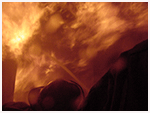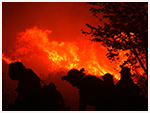« Children and Fire Safety | Home | Candle Fire Safety Practices »
By frhayes | October 7, 2009
| |
|
|
|
|
|
|
|
| |
| |
| |
Escape planning
| |
| |
Draw a home escape plan and discuss it with everyone in your household. |
| |
Practice the plan night and day with everyone in your home twice a year. |
| |
Know at least two ways out of every room, if possible. Make sure all doors and windows leading outside open easily. |
| |
See all safety tips on escape planning. |
|
|
|
Fire can spread rapidly through your home, leaving you as little as two minutes to escape safely once the alarm sounds. Your ability to get out depends on advance warning from smoke alarms, and advance planning – a home fire escape plan that everyone in your family is familiar with and has practiced.
Facts and figures
- Only one-fifth to one-fourth of households (23%) have actually developed and practiced a home fire escape plan to ensure they could escape quickly and safely.
- In 2006, there were an estimated 396,000 reported home structure fires and 2,580 associated civilian deaths in the United States.
- One-thirdof American households who made an estimate thought they would have at least 6 minutes before a fire in their home would become life-threatening. The time available is often less.And only 8% said their first thought on hearing a smoke alarm would be to get out!Source:Harris Interactive Survey, Fall 2004(PDF, 759 KB).
|
|
| |
|
|
| In this Section: |
| |
|
|
|
|
|
|
|
|
|
|
|
Deprecated: Function link_pages is
deprecated since version 2.1.0! Use wp_link_pages() instead. in
/home/firechan/public_html/blog/wp-includes/functions.php on line
6121
Topics: Public Safety | 29 Comments »
Comments


